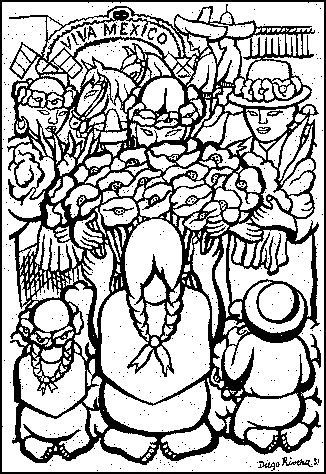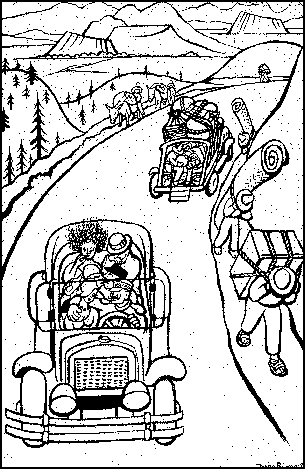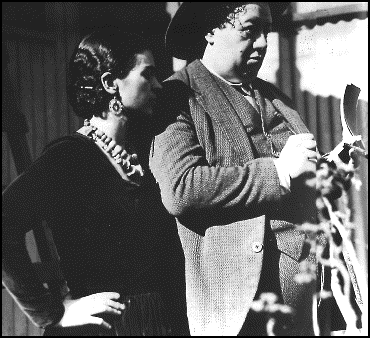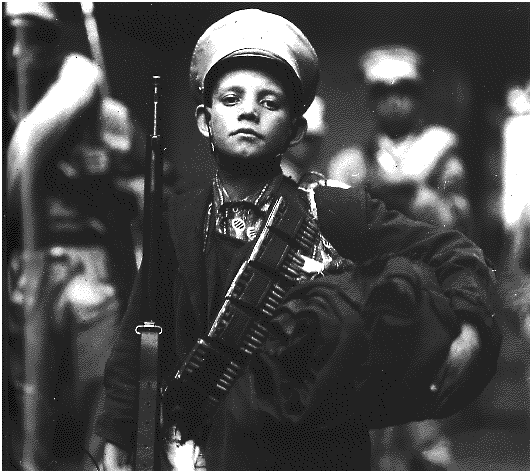Rivera
Pete Hamill
(Abrams)

Be that as it may, Rivera started out as your typical art student, first in Mexico City, then, in the early years of the century, in Paris. He was one of the few Mexicans on that rich art scene before, during, and after WWI (one of the others was Siqueiros).
He counted Seurat, Modigliani, Gris and Lipchitz as friends, roomed with Mondrian, spent months fighting with Picasso. He tried pointillism; he tried cubism, but something made him decide to tackle giant frescoes --- the didactic kind that sooner or later would piss off most people, especially the exotically rich, and the gentlemen of the cloth.
Hamill speculates that Rivera's love of murals may well have come from the two years he stayed in Italy, studying the works of Botticelli, Giotto, della Francesca, and especially Paolo Uccelo --- but others have said that it was the influence of Josť Guadalupe Posada, the engraver of calaveras (portraits for the Day of the Dead) for the popular Mexico City press.
One of Hamill's theses is that Rivera had to be as much an opportunist politician as painter. His choice of mural over canvas was brought about when Josť Vasconcelos, Minister of Education, hired him on to decorate the walls of the Court of the Fiestas in the Ministry of Education building. Over the years he put together 128 different panels that told the history of Mexico, before and after the conquistadores. Rivera, clearly a man of excess, fell on the job with vengeance --- working on it for years, working fourteen hours a day, even, they say, sometimes falling off the scaffold with fatigue.
 Someone as big and rowdy as this had to attract attention from all the right folks, and soon enough Rivera was off to the United States, invited by the likes of the Fords and the Rockefellers. His first job in the U. S. was at the San Francisco Art Institute, where he put together a wonderful mural of the making of a mural, a Chinese box in which Diego Rivera painted in (among others) Diego Rivera --- planted firmly in the middle (with his fat bottom mooning us). The same year, 1931, he had a showing at the Museum of Modern Art in New York, and in 1932, did the walls of the Detroit Institute of Arts with pictures of great machines and mechanical pumps and blowers and assembly lines and chain belts and tubes and workers struggling and punching holes and pulling and pushing and sweating, and in the background the great fires of productivity --- all the paraphernalia of manufacturing. It's all very 30's machine-love stuff, and it's a bit surprising that this revolutionary loved the mindlessness of it all, even as the workers were being turned into automatons. Perhaps that's one of the messages, which would compare these machine-people with the great sex goddesses that lighten the upper portions of the mural.
Someone as big and rowdy as this had to attract attention from all the right folks, and soon enough Rivera was off to the United States, invited by the likes of the Fords and the Rockefellers. His first job in the U. S. was at the San Francisco Art Institute, where he put together a wonderful mural of the making of a mural, a Chinese box in which Diego Rivera painted in (among others) Diego Rivera --- planted firmly in the middle (with his fat bottom mooning us). The same year, 1931, he had a showing at the Museum of Modern Art in New York, and in 1932, did the walls of the Detroit Institute of Arts with pictures of great machines and mechanical pumps and blowers and assembly lines and chain belts and tubes and workers struggling and punching holes and pulling and pushing and sweating, and in the background the great fires of productivity --- all the paraphernalia of manufacturing. It's all very 30's machine-love stuff, and it's a bit surprising that this revolutionary loved the mindlessness of it all, even as the workers were being turned into automatons. Perhaps that's one of the messages, which would compare these machine-people with the great sex goddesses that lighten the upper portions of the mural.
In 1933, Rivera was hired to do the entry at Rockefeller Center, but, being the anti-capitalist wag that he was, he decided beard his patrons by decorating the walls with monied villains pitted against revolutionary heroes --- like Vladimir Ilyich Lenin. The Rockefellers had a snit when they got a gander, and saw red. They covered it up and quickly hammered it to powder. No biggie, says Hamill. It was a lousy fresco anyway: "the propagandist overwhelmed the artist...Cool Diego defeated Warm Diego." That is a bit pollyanna --- for it was a fine, very large chiste --- Rivera twitting the rich in one of their richest mansions. What better practical joke than to plaster the largest walls of the right with leftist cartoons?
 Rivera was a member of the Mexico Communist Party --- when they'd let him --- but, even so, he helped to bring Trotsky to Mexico in 1937. He quickly grew tired of the old man's political rants, and had to get out of town when Trotsky was murdered in 1939. (The second of the three great 20th Century Mexican muralists, David Alfaro Siqueiros, had attempted to murder Trotsky on his own; Rivera was quickly accused of the same crime; these artists took their politics seriously). Since Rivera had been an informant for the U. S. State Department, he was hurried out of Mexico, and spent a year painting a mural at Treasure Island and jawing with visitors.
Rivera was a member of the Mexico Communist Party --- when they'd let him --- but, even so, he helped to bring Trotsky to Mexico in 1937. He quickly grew tired of the old man's political rants, and had to get out of town when Trotsky was murdered in 1939. (The second of the three great 20th Century Mexican muralists, David Alfaro Siqueiros, had attempted to murder Trotsky on his own; Rivera was quickly accused of the same crime; these artists took their politics seriously). Since Rivera had been an informant for the U. S. State Department, he was hurried out of Mexico, and spent a year painting a mural at Treasure Island and jawing with visitors.
His final work of wall art --- at least one that Hamill considers as important as those at the Ministry of Education and the Museo Quaunahuac in Cuernavaca --- was at the Hotel del Prado in Mexico City 1947. It was the usual crowded riot, making it not unlike nightmares some of us have of being jam-packed in an area with people we don't necessarily like, or want to be with. At the same time, Rivera was busy scaring up pesos by doing contract canvases for the Mexican rich --- confirming that it is impossible to saddle him with any other label than "anarchist." Most of his canvases included here show the powerful influence not of Picasso, nor of Giotto, but of Cezanne. However, except for the bizarre Cezannesque imbalances and force fields, they are pretty silly, making the rich look either bored or miserable. His paintings of the indiginos, done at the same time, are blocky, colorful, and give a feeling of pure potential (not kinetic) energy.
Hamill doesn't do badly guiding us through the life and times of Diego Rivera, but several times, he seems to miss the point entirely. He wonders, for instance, why Rivera chose to stay away from Mexico during the Revolution --- 1910 - 1919 --- but from our read of that totally anarchistic eruption, you and I (and Hamill) would probably have stayed the hell out of there too unless we wanted to get offed.
Hamill also wonders why, during Rivera's trip to Russia in 1927, the artist didn't figure out that Stalin was murdering people right and left (to coin a phrase) --- but Hamill forgets, or doesn't know, that the astonishingly murderous nature of Stalin was not easily observable to outsiders; was, indeed, unbelievable to most of the world until long after the brutal collectivization of the kulaks (and for some, only after the Hitler-Stalin pact.) Many from within and without the Soviet Union didn't catch on --- including the Moscow Bureau Chief for the New York Times.
Despite a few failings of the text, Diego Rivera is an excellent way to learn about the master muralists. The descriptions of technique for wall-painting could be a guide book for all would-be frescoistos. For $49.50, you get 50 color illustrations and 50 black and white drawings and photographs. Some of the latter are gratuitous --- for instance, classic photographs of revolutionary Mexico, like the famous shot of Pancho Villa and Emiliano Zapata struggling with knives and forks at lunch, in 1914, at the Palacio Nacional --- or the gorgeous shot of a young soldier girded for battle [below]. Be that as it may, for those who are interested in the eccentric, show-off grandiosity that was and is Rivera, Diego Rivera is well worth it.
